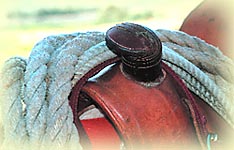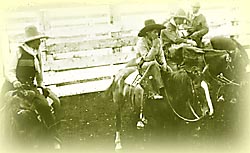Working Cowboys Our dad was a foreman for one of the biggest ranches in Nebraska, the McGinnley Ranch. And he put us boys down to work down there when we were like twelve, thirteen years old. We were working with men, you know, did the same jobs they did, got the same wages they did, all the way from breaking horses to working cattle and putting up hay, all of those things that ranch hands do. So we grew up as working cowboys basically. Our dad always had good horses. We were real poor, I mean we, we didn't have any stock or any range or anything, we just, we were working cowboys. But my dad, even though we were real poor, we had real good horses. Some of the best horses in the country, my dad had. And the way he did this without money, you know, he'd trade around, get a real good mare. Then those ranches that he worked for, he would take the mare down to get bred by his ranch's prize quarter horse, and from that colt then we'd get a real good quarter horse and trade around, get another, another mare. Just through all this horse trading, he wound up with some of the best horses in the country. Victor Runnels, Oglala Lakota, Pine Ridge, South Dakota, January 1996
Joe Coutlee (Nlha7kápmx/French) worked as a cowboy from 1895 to 1945 and was foreman of the Douglas Lake Ranch for many years. Coutlee knew his stock well: out of a herd of 13,000 Short-horns and Herefords, he could identify one that a cowboy had pulled from a bad mud hole two years ago, or one that was just a calf when it lost its tail to a coyote. When rounding up, Coutlee would rest his horse on a high knoll, surveying the cowboys to ensure that he had planned his manœuvres well and that the boys were carrying them out just as faithfully. And always, after a long day, it would be Coutlee who would ride the biggest circle, often coming into camp last. Nina Woolliams, Cattle Ranch: The Story of the Douglas Lake Cattle Company page 1 | page 2 | page 3 | page 4 | page 5 | page 6 | page 7 Introduction | Early Ranching | Ranching Life | Contemporary Ranching Life | Community Stories | Transition to Rodeo SACRED BEINGS | RANCHING | ENTERTAINMENT | RODEO | ARTS AND INDUSTRIES |



